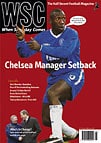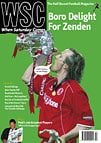 Tuesday 2 Chelsea gazump Man Utd over PSV’s Arjen Robben, who will join them in the summer for £13 million. PSV chairman Harry van Raaij accuses United of cutting their original bid in half: “We were very disappointed over how low they believed they could push us.” The top two in Division One, Norwich and West Brom, draw 0-0 at Carrow Road. Forest, unbeaten in five games under Joe Kinnear, go four points clear of the drop zone after a 1-0 win at Wimbledon. Plymouth stretch their lead in the Second to four points after beating Sheffield Wed 2-0, as Bristol City are held 1-1 at home by Wycombe.
Tuesday 2 Chelsea gazump Man Utd over PSV’s Arjen Robben, who will join them in the summer for £13 million. PSV chairman Harry van Raaij accuses United of cutting their original bid in half: “We were very disappointed over how low they believed they could push us.” The top two in Division One, Norwich and West Brom, draw 0-0 at Carrow Road. Forest, unbeaten in five games under Joe Kinnear, go four points clear of the drop zone after a 1-0 win at Wimbledon. Plymouth stretch their lead in the Second to four points after beating Sheffield Wed 2-0, as Bristol City are held 1-1 at home by Wycombe.
 The once vibrant area of football comic publishing was at death's door through failing to keep up with the times, until Stuart Green's Glory Glory began to rival the long-serving Roy of the Rovers in the early Nineties. Frank Plowright discovers a new title in the football comic world
The once vibrant area of football comic publishing was at death's door through failing to keep up with the times, until Stuart Green's Glory Glory began to rival the long-serving Roy of the Rovers in the early Nineties. Frank Plowright discovers a new title in the football comic world
I once helped produce a football comic. It was the early 1990s and, as co-creator of the Teenage Mutant Ninja Turtles, Kevin Eastman’s income was stratospheric. A lifelong comic fan, he set up Tundra Publishing to finance and publish projects comic writers and artists had always wanted to produce, but which no established company would take on. It would later turn out that, in most cases, there were very good reasons.
 In January the editor responsible for the creation of Roy of the Rovers, the most famous of all football comic strips, died. Neil Rose looks at the life of Derek Birnage’s brainchild, while there have also been more recent developments in the industry
In January the editor responsible for the creation of Roy of the Rovers, the most famous of all football comic strips, died. Neil Rose looks at the life of Derek Birnage’s brainchild, while there have also been more recent developments in the industry
He lost his wife in a mysterious car crash, his left foot in a helicopter accident, eight of his team-mates in a Middle Eastern terrorist attack and in January Roy Race suffered further loss when the man who brought him to the world died, almost 50 years after Racey’s Rocket first slammed into the net.
 Bristol City supporter Mo Davies assesses the standard of League Two and how the rivalry with relegated Rovers is sorely missed
Bristol City supporter Mo Davies assesses the standard of League Two and how the rivalry with relegated Rovers is sorely missed
What have been your best and worst moments?
The best moments are few and far between. I have seen us in the top flight but was a bit young to appreciate it fully. I could revel in Freight Rover/LDV successes, but the promotion seasons have been ultimately more satisfying. The best of which was 1989-90, with Bob Taylor and Robbie Turner terrorising defences up and down the country, including dumping Chelsea out of the FA Cup. The worst was definitely 1982: the club almost went of business and were relegated to Division Four.
 Southend United supporters have been given a rare dose of excitement after the Shrimpers reached the final of the LDV Vans Trophy. Steven Heath has already booked his ticket
Southend United supporters have been given a rare dose of excitement after the Shrimpers reached the final of the LDV Vans Trophy. Steven Heath has already booked his ticket
Southend fans leaving Roots Hall after an extraordinary cup success in February may have reflected on the famous quote from John Cleese’s character in the film Clockwise: “It’s not the despair. I can take the despair. It’s the hope. That’s what I can’t bear.” After years of largely impotent involvement with their football club, this has come to seem like an apposite motto for the average Shrimpers supporter.